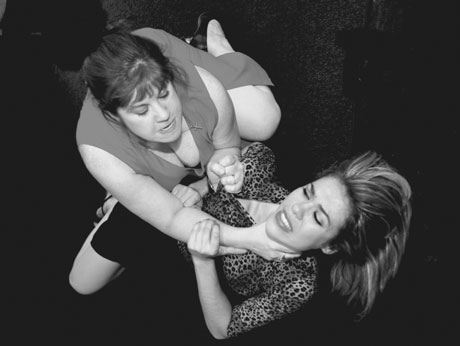By Davida Singer
Diane Greene Lent
Susan Barrett (top) and Heidi James in Rona Munro’s Bold Girls at 29th Street Rep
Scottish writer Rona Munro’s recent film credits include the Golden Globe nominated “Aimee and Jaguar.” Now a new production of her award-winning play, “Bold Girls”, about the lives of four women in Belfast, marks the opening of the fifteenth season for 29th Street Rep.
“This isn’t a story about guns,” Munro has stated. “It’s the story of four bold women.” Greenwich Street Theatre’s Ludovica Villar-Hauser, who’s directing this production, agrees completely. Last week, before rehearsal, she elaborated on Munro and the very particular world that “Bold Girls” encompasses.
DS: What can you say about Rona Munro and her work?
LV: I didn’t know Munro’s work, but quickly I learned that she’s got an incredible mind plus a great heart. This play has such an Irish voice, it didn’t even occur to me she wasn’t Irish. I know that when she wrote “Bold Girls”, she went to live in Belfast in community with these women—complete with late nights and early mornings and a lot of whiskey. It’s a very organic piece that’s all about these four interesting women with interesting lives, and how they relate to each other and society. It was first done in early 1990 in Scotland, then in London in 1991.
DS: When did you get involved in the project?
LV: It got recommended to me only about a month ago. I’d returned from a long stay in England, and I was very ready for a new project. The women at 29th St. Rep really wanted to do this piece. I was told that it was special, I read it and decided it was. It was already cast—3 company members and the person who brought the play to them—so it was perfect. It worked so quickly because these women all know each other.
DS: How are the characters developed in “Bold Girls”?
LV: The balance is incredible and there are so many levels. It’s Catholic Ireland, with lots of do’s and don’ts, steeped in religion, myth and war, and this shows how the women respond in strife to each other. “Bold” is a negative here for girls who are still quite threatening. The story is conventional, but unconventional because of the deep interior monologues—moments in which we get to know them deeply. Munro’s characters—from 16 to mid 50’s—are very, very different. Most women raise children as they’ve been raised. One character, Cassie, in her moment, talks about how we get taught as children. Deidre, a little hoodlum of 16, is looking for her father. To me, she represents Ireland itself, just as Marie is the forgiving Mother Earth.
DS: Is there a plot here?
LV: I don’t see it as a plot. There’s a mother/daughter relationship, a relationship between two friends, and so on. There are no men in this play, but men matter here enormously. They’re not there, but boy, they are! And there are consequences here. It’s a society where women aren’t living with their men. They’re very close communities, where you’re in each other’s homes continually. The women also struggle financially, and with it all, there’s that backdrop of violence.
DS: You’ve directed so many excellent productions. What’s special about this one?
LV: There’s an exhibit in the lobby of photos of women in Belfast by Diane Greene Lent, and a set that truly reflects the play-based in reality and surreal at the same time. Plus, we have amazing music by Irish folk singer Susan McKeown. Then, there’s the speed of this. In a short time, it’s been necessary to understand emotionally where these women came from and how they relate. It’s a tremendous amount of stuff to absorb.
I really hope people allow themselves to go along for the ride. If we’re doing our jobs properly, they will go “Oh”, and do something tiny that’s different in their lives—whatever’s appropriate. In the end, we all have to change. As Marie says, ‘We’re missing each other even when we’re together… and so it will always go on—’til we learn in some way to change, because this place is no different to anywhere else.’



































